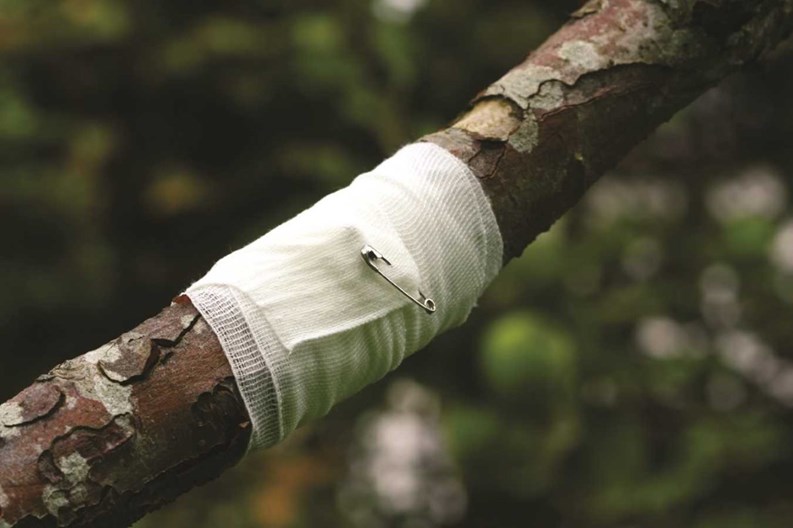When it comes to weather, Chicago's climate conditions are as changing as an adolescent's emotions. One day it's 55 and sunny, the next day you are shoveling snow off your sidewalk. This turbulent weather combined with poor landscaping and a lack of knowledge about proper maintenance can really take a toll on your landscape, particularly your trees.
Although trees stand proud and tall and almost seem to take care of themselves, they still need maintenance and upkeep to stay at their best because they are constantly subjected to damage not only caused by Mother Nature but also by our neglect.
Tree Trouble
Trees in the Chicagoland area are exposed to a slew of threats ranging from weather to insects to lack of maintenance; when it comes to tough stuff, the Windy City’s trees have seen it all.
“The biggest problems that we see are weather-related,” says Jan-Gerrit Bouwman, RLA, MLA, ASLA, a senior landscape architect and partner at Grant & Power Landscaping Inc. in West Chicago. “If it's hot and rainy in the spring, then disease problems are most prevalent on crab apples and other ornamentals. If it's hot and dry, then insect activity is at its highest. Every tree out there in the landscape environment can suffer both insect and disease problems at the same time—depending on the tree, and whether the insect population is at an infestation point.”
Insects are trouble for almost any type of tree variety, and neglecting their predations for too long can severely harm your landscape.
“There are two different types of insects that feed on trees: chewing insects and sucking insects,” says Bouwman. “Chewing insects include Japanese beetles and most other beetle varieties. They can eat one to two times their body weight in a single feeding. Sucking insects include aphids and plant bugs. The plant bugs secrete an acid out of its mouth, then suck out the liquefied plant material. The problem with this bug is once it gets to an infestation point on the landscape, it will feed on everything.” He says that using a tree service for spraying is a preventative way to control the bug population before they overrun the landscape, and ensure that the plant material stays healthy.
Chicago's bustling and congested environment can also take a toll on the well-being of trees. Phil Cleland, president of Chicago Specialty Gardens, Inc., says that pollution, poor soil, lack of shade or sunlight and no surprise, people can stress trees out.
“If there's a lot of people around, plants get abused,” he says. “There's people walking across the parkways, they compact the soil, they dump stuff on it, they let their dogs urinate and defecate on the roots. It's a tough environment for a lot of plants.”
And while salt melts away troublesome ice on sidewalks and roads, it is also one of a tree's worst enemies. Cleland explains that salt damages tree roots, particularly in conifers and evergreens. It also over-salinates the soil, which sucks the moisture out of the plant, causing brown spots on leaves in the spring, and the limbs to die.
What to Plant?
Although nearly any type of tree will beautify a property, there are certain types of trees that fare better in Chicago's sometimes harsh environment than others. Both Bouwman and Cleland agree that maples, oaks, crab trees, beeches, birches and locust trees are most commonly used on condo properties and seem to mature healthily as long as they are properly cared for.
“People have tried everything in this town,” says Cleland. “For some reason, particularly in condos, the same plants get used over and over because they're successful. It's just not a situation where you want to be experimenting a whole lot.” So you may have loved sitting under a palm tree during your last trip to Florida, but planting one on your association's landscape may not be so successful.
Cleland says that some associations will experiment with new hybrids and varieties but due to budgetary restraints, they tend to stick to what has worked for them in the past.
While certain trees are better suited for Chicago's vacillating climate that does not mean they are immune to everything. Bouwman says maples and gingkos for example, are less prone to insect damage but can be hit hard with fungus, depending on how hot and rainy it is. “A lot of it depends on the weather conditions. Every plant out there is susceptible to damage.”
Healthy Tree Tips
The maintenance of trees depends of course on the type but there are some basic care strategies that can be applied to all. And it begins with a simple step.
“It all starts with having the right plants in the right space—that's really the very elementary thing to keep in mind whenever you're planting something new or designing a space,” says Cleland. “Finding the right plant for those conditions that you have is really the best place to start. Because if you've got a lot of shade, crummy soil, poor drainage and so forth, you just can't plant a plant in there that needs a lot of sun, well-drained soil, it's just going to be a nonstarter.”
Once you have chosen a tree that will thrive in your circumstances, it's time to feed--trees need nourishment too. According to Bouwman, feeding should be done twice a year, in the spring and fall.
“In the spring, you feed them to replenish the food supplies that were used to push up the leafing and the flowering and protect them in the summertime. And in the fall, you are setting up next spring's leafing. A lot of [associations] figure that trees get their food from the ground and they're fine. They live a long time, but improper feeding can mean a quicker die off inside a tree and mechanical damage such as dead branching,” he says.
Cleland recommends doing seasonal checkups on trees to ensure that they will flourish through the season and be protected and ready for the following one.
“As you get into summer, you want to again just make sure that the plant is getting what it needs: check for pests, check the leaves to make that they are doing properly, they're not droopy, they're not falling, yellowing or they haven't got pest problems,” he says.
“Into fall, some younger trees might need to have their trunks wrapped to prevent splitting during the winter, so you might wrap the tree trunks in burlap for newer trees. You might do some limited fall fertilization,” he continues.
Cleland says that winter prep means doing any additional pruning, mulching or things of that nature. “You want the plant to go into winter fully hydrated, not stressed. And as you do that you are increasing your odds of it doing well and surviving. Another kind of environmental factor we run into in Chicago is the wind. Winds can damage plants quite a bit. So you want to try to avoid wind damage by properly setting the plant—planting a stronger tree where the wind is strongest,” he says.
For more tree specific care you should consult with your arborist and landscaping company to devise a plan that will keep your trees healthy and thriving in all seasons.
Trees that manage to endure Chicago's wild weather deserve a little tender loving care—and associations that appreciate the beauty those trees contribute to the community would do well to take steps to prepare them.
Lisa Iannucci is a freelance writer and a frequent contributor to The Chicagoland Cooperator. Editorial Assistant Maggie Puniewska contributed to this article.





Leave a Comment